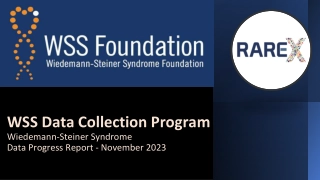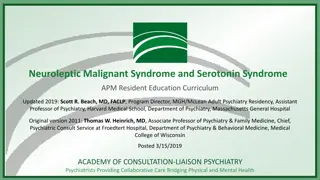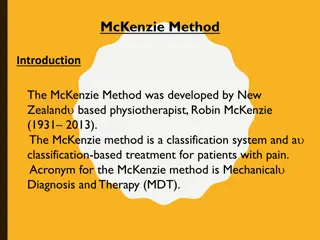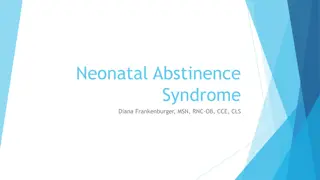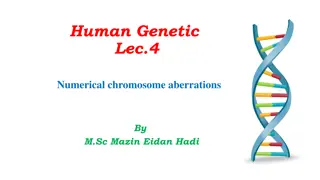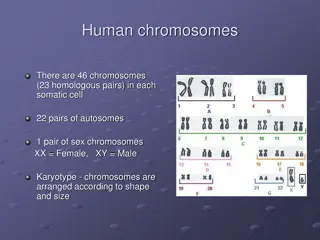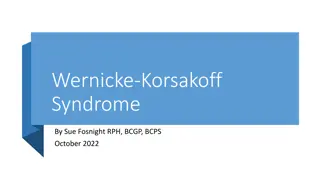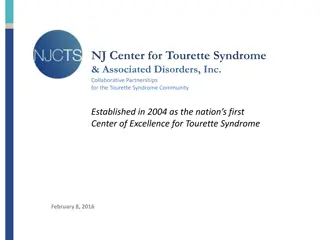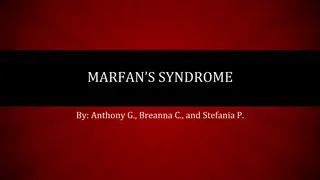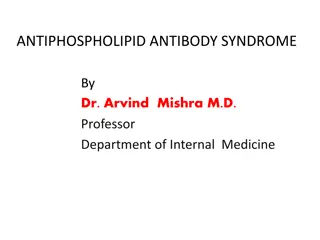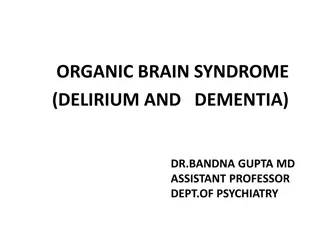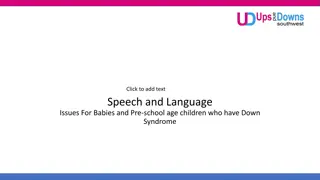Understanding Down Syndrome: Types, Characteristics, and Impacts
Down syndrome is a genetic condition caused by an extra chromosome, typically chromosome 21. This leads to physical and cognitive challenges, with individuals exhibiting unique abilities. The syndrome presents with distinctive physical features, such as flattened face, almond-shaped eyes, and poor muscle tone. There are three types of Down syndrome, namely Trisomy 21, Translocation Down syndrome, and Mosaic Down syndrome, each with varying chromosomal characteristics. Despite similarities in appearance, individuals with Down syndrome have diverse capabilities and may require specialized support.
Download Presentation

Please find below an Image/Link to download the presentation.
The content on the website is provided AS IS for your information and personal use only. It may not be sold, licensed, or shared on other websites without obtaining consent from the author. Download presentation by click this link. If you encounter any issues during the download, it is possible that the publisher has removed the file from their server.
E N D
Presentation Transcript
Facts about Down Syndrome What is Down Syndrome? Down syndrome is a condition in which a person has an extra chromosome. Chromosomes are small packages of genes in the body. They determine how a baby s body forms and functions as it grows during pregnancy and after birth. Typically, a baby is born with 46 chromosomes. Babies with Down syndrome have an extra copy of one of these chromosomes, chromosome 21. A medical term for having an extra copy of a chromosome is trisomy. Down syndrome is also referred to as Trisomy 21. This extra copy changes how the baby s body and brain develop, which can cause both mental and physical challenges for the baby.
Even though people with Down syndrome might act and look similar, each person has different abilities. People with Down syndrome usually have an IQ (a measure of intelligence) in the mildly-to-moderately low range and are slower to speak than other children.
Some common physical features of Down syndrome include: A flattened face, especially the bridge of the nose Almond-shaped eyes that slant up A short neck Small ears A tongue that tends to stick out of the mouth Tiny white spots on the iris (coloured part) of the eye Small hands and feet A single line across the palm of the hand (palmar crease) Small pinky fingers that sometimes curve toward the thumb Poor muscle tone or loose joints Shorter in height as children and adults
Types of Down Syndrome There are three types of Down syndrome. People often can t tell the difference between each type without looking at the chromosomes because the physical features and behaviours are similar. Trisomy 21:About 95% of people with Down syndrome have Trisomy 21.With this type of Down syndrome, each cell in the body has 3 separate copies of chromosome 21 instead of the usual 2 copies.
Translocation Down syndrome: This type accounts for a small percentage of people with Down syndrome (about 3%). This occurs when an extra part or a whole extra chromosome 21 is present, but it is attached or trans-located to a different chromosome rather than being a separate chromosome 21. Mosaic Down syndrome: This type affects about 2% of the people with Down syndrome. Mosaic means mixture or combination. For children with mosaic Down syndrome, some of their cells have 3 copies of chromosome 21, but other cells have the typical two copies of chromosome 21. Children with mosaic Down syndrome may have the same features as other children with Down syndrome. However, they may have fewer features of the condition due to the presence of some (or many) cells with a typical number of chromosomes.
Causes and Risk Factors The extra chromosome 21 leads to the physical features and developmental challenges that can occur among people with Down syndrome. Researchers know that Down syndrome is caused by an extra chromosome, but no one knows for sure why Down syndrome occurs or how many different factors play a role. One factor that increases the risk for having a baby with Down syndrome is the mother s age. Women who are 35 years or older when they become pregnant are more likely to have a pregnancy affected by Down syndrome than women who become pregnant at a younger age. However, the majority of babies with Down syndrome are born to mothers less than 35 years old, because there are many more births among younger women.
Diagnosis There are two basic types of tests available to detect Down syndrome during pregnancy: screening tests and diagnostic tests. A screening test can tell a woman and her healthcare provider whether her pregnancy has a lower or higher chance of having Down syndrome. Screening tests do not provide an absolute diagnosis, but they are safer for the mother and the developing baby. Diagnostic tests can typically detect whether or not a baby will have Down syndrome, but they can be more risky for the mother and developing baby. Neither screening nor diagnostic tests can predict the full impact of Down syndrome on a baby; no one can predict this.
Screening Tests Screening tests often include a combination of a blood test, which measures the amount of various substances in the mother s blood (e.g., MS-AFP, Triple Screen, Quad-screen), and an ultrasound, which creates a picture of the baby. During an ultrasound, one of the things the technician looks at is the fluid behind the baby s neck. Extra fluid in this region could indicate a genetic problem. These screening tests can help determine the baby s risk of Down syndrome. Rarely, screening tests can give an abnormal result even when there is nothing wrong with the baby. Sometimes, the test results are normal and yet they miss a problem that does exist.
Diagnostic Tests Diagnostic tests are usually performed after a positive screening test in order to confirm a Down syndrome diagnosis. Types of diagnostic tests include: Chorionic villus sampling (CVS) examines material from the placenta Amniocentesis examines the amniotic fluid (the fluid from the sac surrounding the baby) Percutaneous umbilical blood sampling (PUBS) examines blood from the umbilical cord These tests look for changes in the chromosomes that would indicate a Down syndrome diagnosis.
Other Health Problems Many people with Down syndrome have the common facial features and no other major birth defects. However, some people with Down syndrome might have one or more major birth defects or other medical problems. Some of the more common health problems among children with Down syndrome are listed below. Hearing loss Obstructive sleep apnea, which is a condition where the person s breathing temporarily stops while asleep Ear infections Eye diseases Heart defects present at birth Health care providers routinely monitor children with Down syndrome for these conditions.
Treatments Down syndrome is a lifelong condition. Services early in life will often help babies and children with Down syndrome to improve their physical and intellectual abilities. Most of these services focus on helping children with Down syndrome develop to their full potential. These services include speech, occupational, and physical therapy, and they are typically offered through early intervention programs in each state. Children with Down syndrome may also need extra help or attention in school, although many children are included in regular classes.
References 1.Mai CT, Isenburg JL, Canfield MA, Meyer RE, Correa A, Alverson CJ, Lupo PJ, Riehle Colarusso T, Cho SJ, Aggarwal D, Kirby RS. National population based estimates for major birth defects, 2010 2014. Birth Defects Research. 2019; 111(18): 1420-1435. 2.Shin M, Siffel C, Correa A. Survival of children with mosaic Down syndrome. Am J Med Genet A. 2010;152A:800-1. 3.Allen EG, Freeman SB, Druschel C, et al. Maternal age and risk for trisomy 21 assessed by the origin of chromosome nondisjunction: a report from the Atlanta and National Down Syndrome Projects. Hum Genet. 2009 Feb;125(1):41-52. 4.Ghosh S, Feingold E, Dey SK. Etiology of Down syndrome: Evidence for consistent association among altered meiotic recombination, nondisjunction, and maternal age across populations. Am J Med Genet A. 2009 Jul;149A(7):1415-20. 5.Sherman SL, Allen EG, Bean LH, Freeman SB. Epidemiology of Down syndrome. Ment Retard Dev Disabil Res Rev. 2007;13(3):221-7. 6.Adams MM, Erickson JD, Layde PM, Oakley GP. Down s syndrome. Recent trends in the United States. JAMA. 1981 Aug 14;246(7):758-60. 7.Olsen CL, Cross PK, Gensburg LJ, Hughes JP. The effects of prenatal diagnosis, population ageing, and changing fertility rates on the live birth prevalence of Down syndrome in New York State, 1983-1992. Prenat Diagn. 1996 Nov;16(11):991-1002. 8.Bull MJ, the Committee on Genetics. Health supervision for children with Down syndrome. Pediatrics. 2011;128:393-406.



![❤[PDF]⚡ Zee Zee Does It Anyway!: A Story about down Syndrome and Determination](/thumb/20462/pdf-zee-zee-does-it-anyway-a-story-about-down-syndrome-and-determination.jpg)
